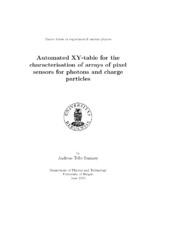| dc.description.abstract | A variety of arrays of pixels sensors (pixel = picture elements) have been developed during the last 30 years for the detection of photons and charge particles. Pixel based semiconductor detectors are not only used for sensing position. The new pixel based Geiger mode APDs (G-APDs) are created to measure light intensities, or even to count single photons. There are several different G-APD designs with minor differences. The hope is that some of these new designs will replace the Photo Multiplier Tube (PMT) and the Avalanche PhotoDiode (APD) for reading out scintillation crystals. The properties of the G-APDs are still being tested, but the prospects look promising. The motivation for this thesis was to build a setup that could test the response of a single G-APD pixel as part of an overall work to characterise G-APDs. Last year Hege A. Erdal delivered her master thesis (1) where she has characterised two types of G-APDs and Ph.d. student Njål Brekke is looking into Time of Flight (ToF) Positron Emission Tomography (PET) by the use of G-APDs. Even though the current focus is on G-APDs, any setup capable of testing single pixels should also be able to test position detectors in the future with some alteration. The setup is based on an XY-table from the particle physics group at IFT. The XY-table mainly consists of three microstepper stages that can move a detector in all three dimensions with a microscope above for inspection. An automated system that can trigger every pixel on a G-APD has been implemented. After developing programs to locate single pixels on G-APDs it was noticed that the microstepper stages were flawed and moved incorrectly. The microstepper stages of the XY-table have been characterised by the use of a fine calibration grid, and their fault has been quantifed. After several failures to correct for this in software a program which uses pattern matching was successfully implemented. This has been the most time consuming partof the thesis. In order to trigger single pixels without triggering neighbouring pixels, they must be struck by a narrow, fast light pulse. The pixels are triggered by focusing light pulses from a LED through the microscope. This has proven to be an effective way of triggering pixels. The reproduceability of this setup has been tested by comparing several series of measurements of the same G-APD. Between each series, parts have been dismantled and then reassembled again. These tests has shown that the setup's reproducibility is within the specification when determining e.g. the gain of the G-APD. Two types of MPPCs have been tested: The first measurements of the response of the MPPC indicate that there are no dead pixels, one of the detectors have a uniform gain across the pixels, while the other show a distinct gain pattern across the pixels. | en_US |
